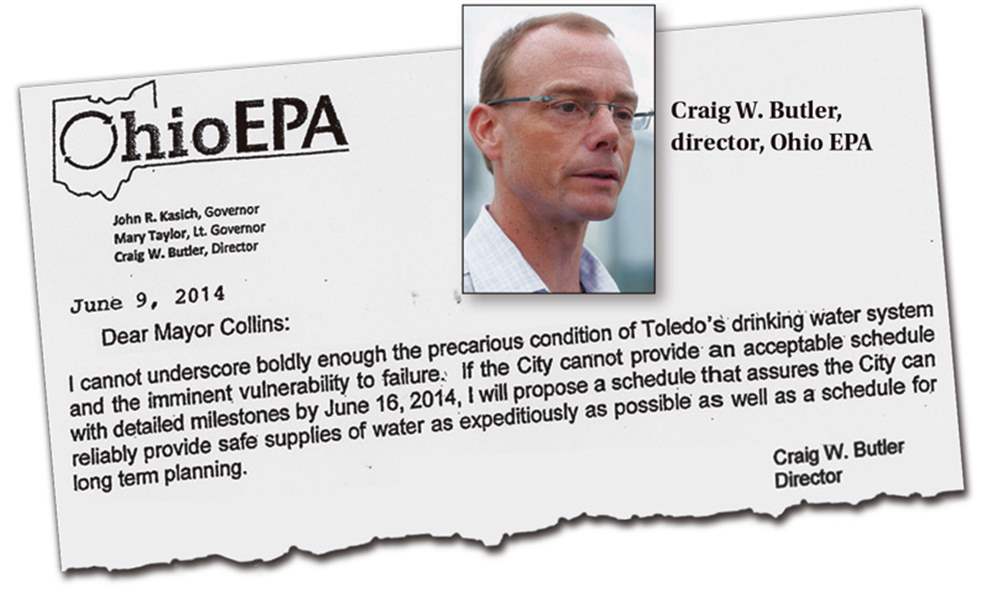
Ohio EPA warned Toledo of ‘imminent vulnerability’
Collins told in June of likelihood of dire water problems
8/7/2014

Craig W. Butler, director, Ohio EPA.
Less than two months before a historic algae-induced water crisis left 500,000 metro Toledo residents scrambling for bottled water, Ohio’s top environmental regulator warned Toledo Mayor D. Michael Collins that the city’s Collins Park Water Treatment Plant was “vulnerable to potential failures that could severely impact the city’s ability to provide adequate quantities of safe water to its citizens.”
“I cannot underscore boldly enough the precarious condition of Toledo’s drinking water system and the imminent vulnerability to failure,” Ohio Environmental Protection Agency Director Craig W. Butler wrote in a June 9 letter to Mr. Collins, a copy of which was obtained by The Blade on Thursday through a public records request along with a stack of other documents and copies of emails that show the agency had severe reservations about the plant for months leading up to the crisis.
While some of the records document how area officials worked with the state in planning and executing tabletop exercises over various scenarios of potential algae contamination, most of the concerns are related to aging infrastructure, chemical storage, and the general condition of equipment used for normal operations, especially longstanding concerns about the need to upgrade low-service pumps along the Oregon shoreline, which are used to power raw lake water from the city’s intake crib in western Lake Erie to the treatment plant.
But despite a lengthy exchange of concerns expressed in recent years, the June 9 letter from Mr. Butler asserted the “Ohio EPA is not yet convinced that adequate progress is being made.”
Similar concerns were expressed in a March 31 letter that Mike Baker, the Ohio EPA’s drinking and ground waters division chief, wrote to Bob Reinbolt, Mr. Collins’ chief of staff, and Robin Whitney, the city’s former public utilities director.
“We emphasized the need to accelerate your purchasing process and complete these projects with the same urgency that would be necessitated were a failure to actually occur,” the letter stated in regard to a long backlog of necessary repairs and upgrades. “Another priority item is the development of a more robust emergency plan, given the condition of the infrastructure and the amplified risk of failure during the construction of projects.”
■ Read the June 9 letter to Mayor Collins in its entirety
■ Letter to Public Utilities Director David Welch, Dec. 2, 2013
■ Letter to Public Utilities Director David Welch, Aug. 7, 2013
■ Letter from Division of Drinking and Ground Waters
Mayor Collins, who said he has urged improvements at the water plant since his days as a city councilman, received a letter in the first month of his administration reminding him of the need to move faster than previous administrations.
“The city of Toledo faces significant challenges completing a large number of critical infrastructure projects to ensure a reliable and safe source of drinking water,” Mr. Baker wrote in a Jan. 30 letter to Mr. Collins.
In an interview with The Blade on Thursday night, Mr. Collins said he was taken aback by the sharp tone of Mr. Butler’s June 9 letter.
“Those are very strong words,” Mr. Collins said. “I said ‘Rather than be adversarial, let’s work together. We cannot solve anything if we’re fighting over who’s right.”
He said Mr. Butler agreed it was in everyone’s best interest to work together.
“The city has a plan. There are no secrets. We have a plan. That plan started when I took office and said to fix it [the water plant],” Mr. Collins said.
Ohio EPA Deputy Director of Communications Chris Abbruzzese confirmed the agency has “been having regular meetings with the city” since receiving a response on behalf of Mr. Collins from Ed Moore, who took over as the city’s public utilities director in April.
Toledo councilmen authorized $300 million in improvements in 2013 after former Toledo Mayor Michael Bell’s administration brought a number of the Ohio EPA’s longstanding concerns to the city council. Much of that money is going toward a new unit capable of producing another 40 million gallons per day of water, as well as a new roof, and new water mains throughout the distribution system.
In an interview inside the water plant Thursday, city officials also showed The Blade plans for an end-of-treatment finishing unit that will be designed to make the plant more effective at combating microcystin, the toxin in microcystis algae that caused last weekend’s unprecedented advisory against drinking city-produced tap water for three days. That addition to the plant has yet been designed. It will deploy ozone or granulated carbon as its primary feature. It is expected to be completed and running in 2018 or 2019, officials said.
Andy McClure, Collins Park Water Treatment Plant superintendent, said there is no connection between long-overdue upgrades and the algae spike that made the tap water undrinkable.
“I can’t identify anything that went on that would have affected the toxins,” Mr. McClure said. “The Ohio EPA is aware of the age and the condition of the facility, and they have an appropriate concern.”
But Mr. Abbruzzese said the longstanding issues, while not directly related to the algae problem, are further evidence of “a larger and urgent infrastructure concern” with Toledo’s water treatment facility.
Councilman Lindsay Webb, chairman of the city’s utilities and public service committee, was irked she did not see the scathing June 9 letter that Mr. Butler had sent to the mayor.
“In my estimation, part of the lack of communication to me and the lack of responsiveness to the EPA has to do with staff changes,” she said Thursday night.
She said the city has an obligation to meet deadlines, especially after council passed water-rate increases in 2013 to fund the overdue work.
Councilman Jack Ford also said he didn’t know about the June 9 letter to Mayor Collins, whom he said should have brought it to the council’s attention. He called the correspondence a “red-flag that should have been responded to.”
Had council members been kept up to date on the Ohio EPA’s concerns about improvements needed at the water treatment plant “there would have been a greater sense of urgency,” Mr. Ford said.
Blade staff writer Vanessa McCray contributed to this story.
Contact Tom Henry at: thenry@theblade.com or 419-724-6079.